coolant AUDI A3 2015 User Guide
[x] Cancel search | Manufacturer: AUDI, Model Year: 2015, Model line: A3, Model: AUDI A3 2015Pages: 288, PDF Size: 71.46 MB
Page 214 of 288
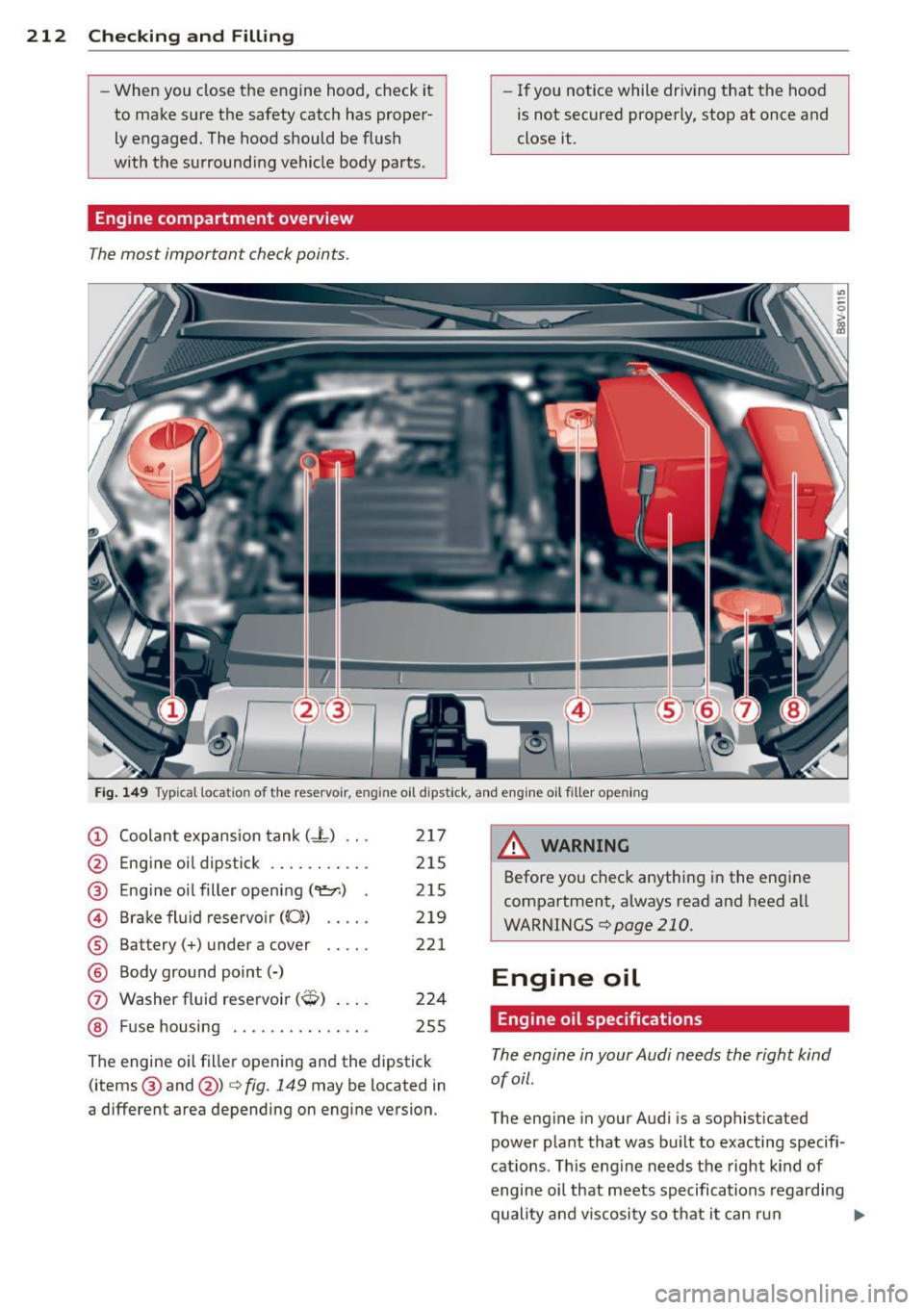
212 Checking and Filling
- When you close the engine hood, check it
to make sure the safety catch has proper
ly engaged. The hood should be flush
with the surrounding vehicle body parts.
Engine compartment overview
The most important check points.
- If you notice while driv ing that the hood
is not secured properly, stop at once and
close it.
Fig. 149 Typ ica l locat ion of the reservoir, en g in e oil d ipstick, and engine o il filler opening
(D Coolant expansion tank (- L) .. .
@ Engine oi l dipstick ... .... .. . .
® Engine oil filler opening (~) .
@ Brake fluid reservo ir ((0)) .. .. .
® Battery(+) under a cover .. .. .
@ Body ground point(-)
0 Washer f luid reservoir (~) ... .
@ Fuse housing ....... .... ... .
2 17
215
215
219
221
224
255
The engine oil filler opening and the dipstick (items ® and @)
c::> fig. 149 may be located in
a different area depending on engine version .
A WARNING ,...,___ -
Before you check anything in the engine
compartment, always read and heed all
WARNINGS
c::> page 210.
Engine oil
Engine oil specifications
The engine in your Audi needs the right kind
of oil.
The eng ine in your Audi is a sophisticated
power plant that was built to exacting specifi
cations . This engine needs the right kind of
engine oil that meets specifications regarding
quality and v iscosity so that it can run
II>-
Page 218 of 288
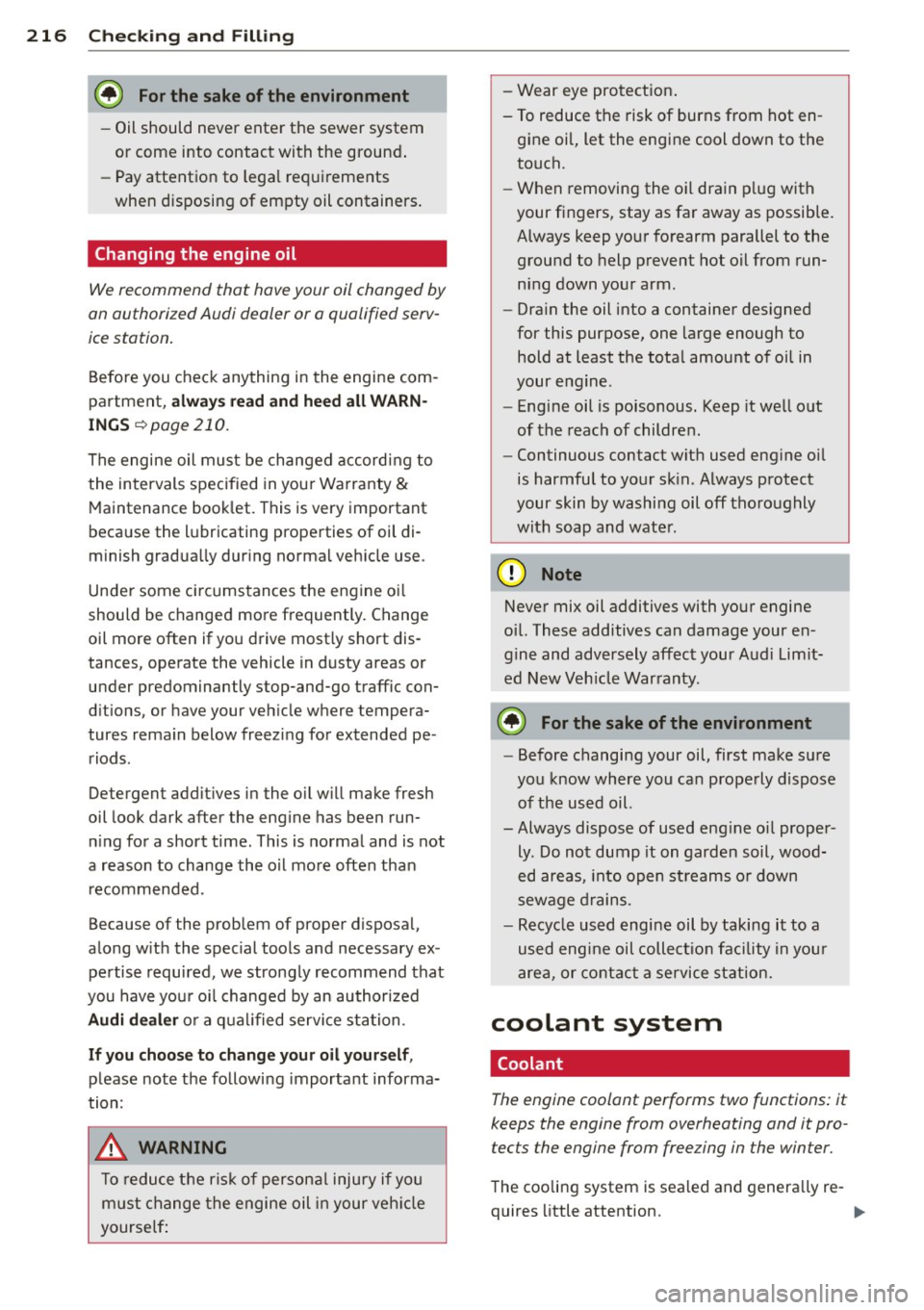
216 Check ing and F illin g
@ For the sake of the environment
-Oil should never enter the sewer system
or come into contact with the ground .
- Pay attentio n to lega l requ irements
when disposing of empty oil containers .
Changing the engine oil
We recommend that have your oil changed by
an authorized Audi dealer or a qualified serv
ice station.
Before you check anything in the engine com
partment,
a lways r ea d and heed all WARN
ING S
r=>page 210.
The engine oil must be changed according to
the intervals specified in you r Warranty
&
Maintenance book let. This is very important
because the lubricating properties of oil di
minish gradua lly during norma l veh icle use.
Under some circumstances the engine oi l
should be changed more frequently. Change
oil more often if you drive most ly short dis
tances, operate the vehicle in dusty areas or
under predominantly stop-and-go traffic con
ditions, or have your vehicle where tempera
tures remain below freezing for extended pe riods .
Detergent additives in the oil will make fresh
oil look dark after the eng ine has been run
n ing for a short time. This is normal and is not
a reason to change the oil more often than recommended.
Because of the problem of proper disposal,
along w ith the special tools and necessary ex
pertise required, we strongly recommend that
you have you r o il changed by an author ized
A udi de ale r or a q ual ified servi ce station.
If yo u choo se to c hang e your o il yo urse lf,
please note the following important informa
tion :
.8, WARNING
To reduce the ris k of persona l injury if yo u
m ust change the engine oil in your veh icle
yourself : -
Wear eye protection .
- To reduce the risk of burns from hot en -
gine oi l, let the engine cool down to the
touch.
- When removing the oil drain p lug with
your fingers, stay as far away as possible.
Always keep your forearm parallel to the
ground to help prevent hot oil from running down your arm.
- Drain the oil into a container designed
for this purpose, one large enough to
hold at least the tota l amount of oil in
your engine.
- Engine oil is poisonous. Keep it we ll out
of the reach of childre n.
- Continuous contact with used eng ine o il
is harmful to your sk in . Always protect
your skin by washing oil
off tho roughly
with soap and water.
(D Note
Never mix oil additives with your engine
oil. These additives can damage your en
gine and adversely affect your Aud i Limit
ed New Veh icle Warranty.
@ For the sake of the environment
- Before changing your oil, first make sure
yo u know where you can properly dispose
of the used oil.
- Always dispose of used eng ine oil proper
ly. Do not dump it on garden soil, wood
ed areas, into open st reams o r down
sewage drains.
- Recycle used engine oil by taking it to a
used eng ine oil collect io n fac ility in you r
are a, or contact a se rvice station.
coolant system
Coolant
The engine coolant performs two functions: it
keeps the engine from overheating and it pro tects the engine from freezing in the winter.
The cooling system is sealed and genera lly re-
quires little attention. .,..
Page 219 of 288
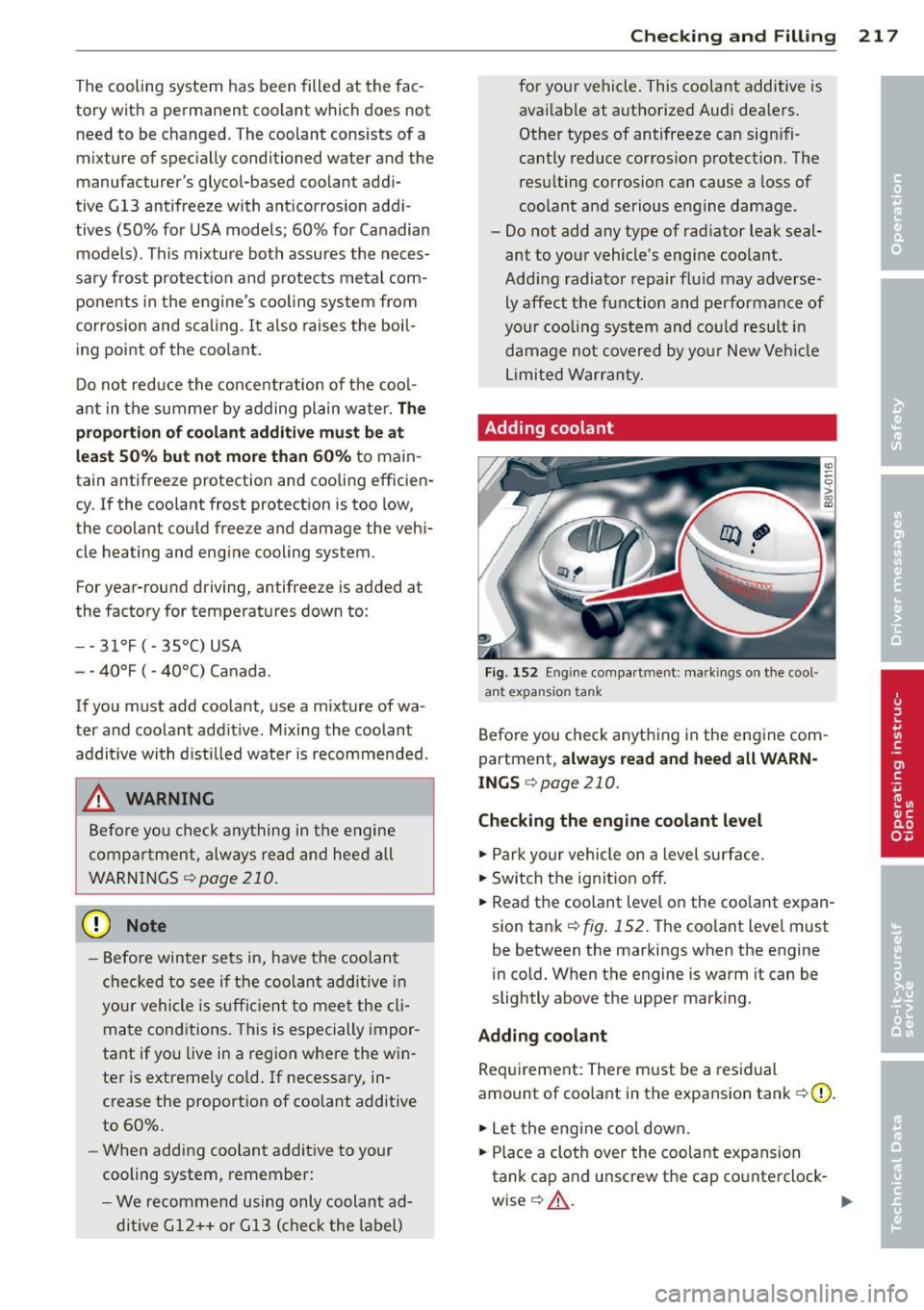
The cooling system has been filled at the fac
tory with a permanent coolant which does not need to be changed. The coolant consists of a
mixture of spec ia lly conditioned water and the
manufacturer's glycol-based coolant addi-
tive Gl3 antifreeze with anticorros ion addi
tives (50% fo r USA models; 60% for Canadian
models) . This mixture both assures th e neces
sary frost protect ion a nd p rotects me tal com
ponents in the engine 's coo ling system from
corrosion and scaling.
It al so raises the boil
ing po int o f the coo lant .
D o no t reduce the concentration of t he coo l
an t in the summer by ad ding plain w ate r.
The
proportion of coolant additive must be at
lea st 50 % but not more than 60%
to main
tain ant ifreeze protection and cooling efficien
cy. If the coolant frost protect ion is too low ,
the coolant cou ld free ze and damage the veh i
cle heating and eng ine cooling system.
F or yea r-round driv ing, antifreeze is added at
the facto ry for temperatures down to:
- -3 1 °F ( -3 5°C) USA
- -4 0°F ( -4 0°C) Canada.
If you must add coolant, use a m ixture of wa
ter and coolant addit ive. M ixing the coolant
addi tive wi th dist illed wate r is recom mend ed.
_& WARNING
Bef ore yo u check any thing in the e ngine
comp artme nt, alw ays re ad and hee d all
WARN INGS
¢page 210.
(D Note
- B efo re winter sets in, have the coolant
c hec ked to see if the c oolan t ad dit ive i n
you r vehi cle is su fficient t o mee t the cl i
mate cond itions. This is especially impor
tant if yo u live in a region whe re the win
ter is extremely cold. If necessary, in
crease the proport ion of coolant additive
to 60%.
- W hen addi ng coolant additive to your
cooling system, remember:
- We recommend using only coolant ad
ditive Gl2 ++ o r Gl3 ( check t he label)
-
Che cking and Fillin g 21 7
for you r vehi cle. This coolan t additive is
avai lab le at authorize d Audi dea le rs .
Ot her types of antifreeze ca n sig nifi
cantly reduce corros io n protection. The
res ulting corrosion can cause a loss of
coolant and serio us e ngine da mage .
- Do not add any type of rad iator leak seal
ant to you r vehicle's engine coolant .
Add ing radiator repair flu id may adverse
ly affect t he function and performanc e of
yo ur cooling sys tem and co uld resu lt i n
damage not covered by yo ur New Ve hicle
L imi ted W arranty.
Adding coolant
Fi g. 152 En gine co mpa rtment: markin gs on t he coo l
an t e xpan sio n t ank
Befo re you check a nyt hing in the eng ine com
partment ,
alway s read and heed all WARN
INGS ¢ page 210.
Checking the engine coolant level
.,. Park yo ur vehicle o n a level su rf a ce .
.,. Switch t he ignition off.
.,. Read t he coolant leve l on the coo lant expan
sion tank ¢
fig. 152. The coolant leve l must
be between the markings when the engine
in cold. When the engine is warm it can be
slightly above the upper mark ing .
Adding coolant
Req uirement : There m ust be a res idual
amount of coo lant in the expansion tank
c::> Q) .
.,. Le t the engine cool down.
.,. Place a clot h over the coo lant expans ion
tank cap a nd u nscrew the cap co unterclock-
wise
c::> _& . ..,.
Page 220 of 288
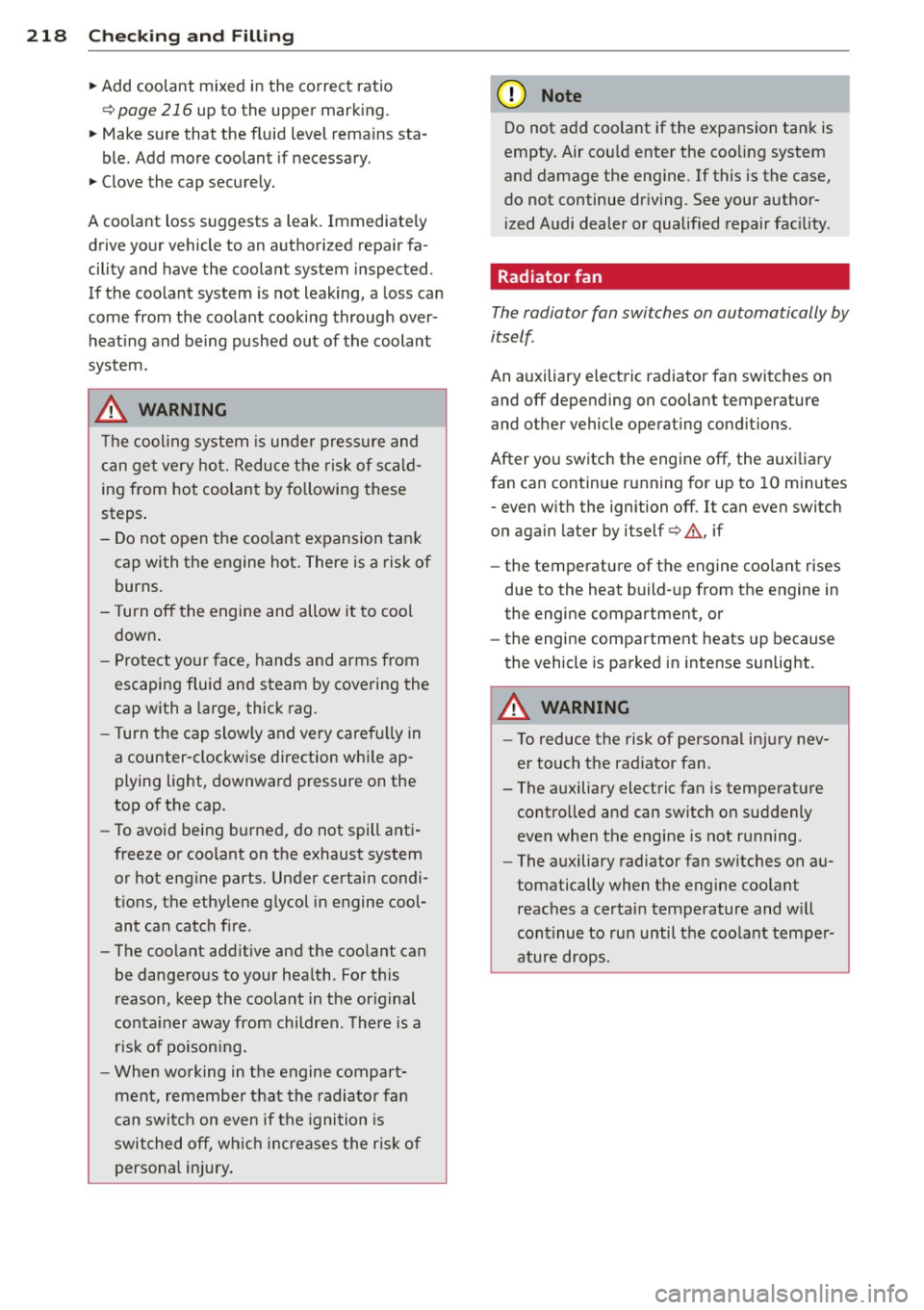
218 Check ing and F illin g
• Add coolant mixed in the correct ratio
¢page 216 up to the upper marking.
• Make sure that the fluid level rema ins sta-
ble. Add more coolant if necessary.
• Clove the cap securely.
A coo lant loss suggests a leak. Immediately
drive your vehicle to an authorized repair fa
cility and have the coolant system inspected.
If the coolant system is not leaking, a loss can
come from the coolant cooking through over
heat ing and being pushed out of the coolant
system.
.8, WARNING
The cool ing system is under pressure and
can get very hot. Reduce the risk of scald
ing from hot coolant by following these
steps .
- Do not open the coo lant expansion tank
cap with the engine hot . There is a risk of
burns.
- T urn off the engine and allow it to cool
down .
- Protect your face, hands and arms from
escaping fluid and steam by covering the
cap with a large, thick rag.
- T urn the cap slowly and ve ry carefu lly in
a counter-clockwise direction wh ile ap
plying light, downward pressure on the
top of the cap.
- To avoid being b urned, do not spill anti
freeze or coo lant on the exhaust system
or hot eng ine parts. Under certain condi
t ions, the ethylene g lycol in engine cool
ant can catch fire.
- The coo lant add itive and the coolant can
be dange rous to your hea lth. For th is
reason, keep the coolant in the or ig inal
conta iner away from children. There is a
risk of poisoning.
- Whe n work ing in the engine compart
ment, remembe r that the radiator fan
can swit ch on even if the ignition is
switched off, wh ic h increases the risk of
persona l inju ry .
(D Note
Do not add coo lant if the expansion tank is
empty. Air cou ld enter the cooling system
and damage the engine. If this is the case,
do not continue dr iving. See your author
i zed Audi dealer or qualified repair fac ility .
Radiator fan
The radiator fan switches on automatically by
itself
An a uxiliary electric radiator fan switches on
and off depending on coolant temperature
and other vehicle operat ing condit ions.
After you switch the engine off, the auxi liary
fan can continue running for up to 10 m inutes
- even w ith the ignition off.
It can even switch
on again later by itself¢.&. , if
- the temperature of the engine coo lant rises
due to the heat build- up from the engine in
the engine compartment, or
- the engine compartment heats up because
the vehicle is parked in intense sunlight.
.8, WARNING ,-
- To reduce the risk of personal injury nev-
er touch the radiator fan.
- The a uxiliary electric fan is temperat ure
controlled and can sw itch on suddenly
even when the engine is not ru nning.
- The auxiliary radiator fan sw itches on a u
tomatically when the engine coo lant
reaches a certain temperature and will
continue to run until the coolant temper
ature drops.
Page 226 of 288
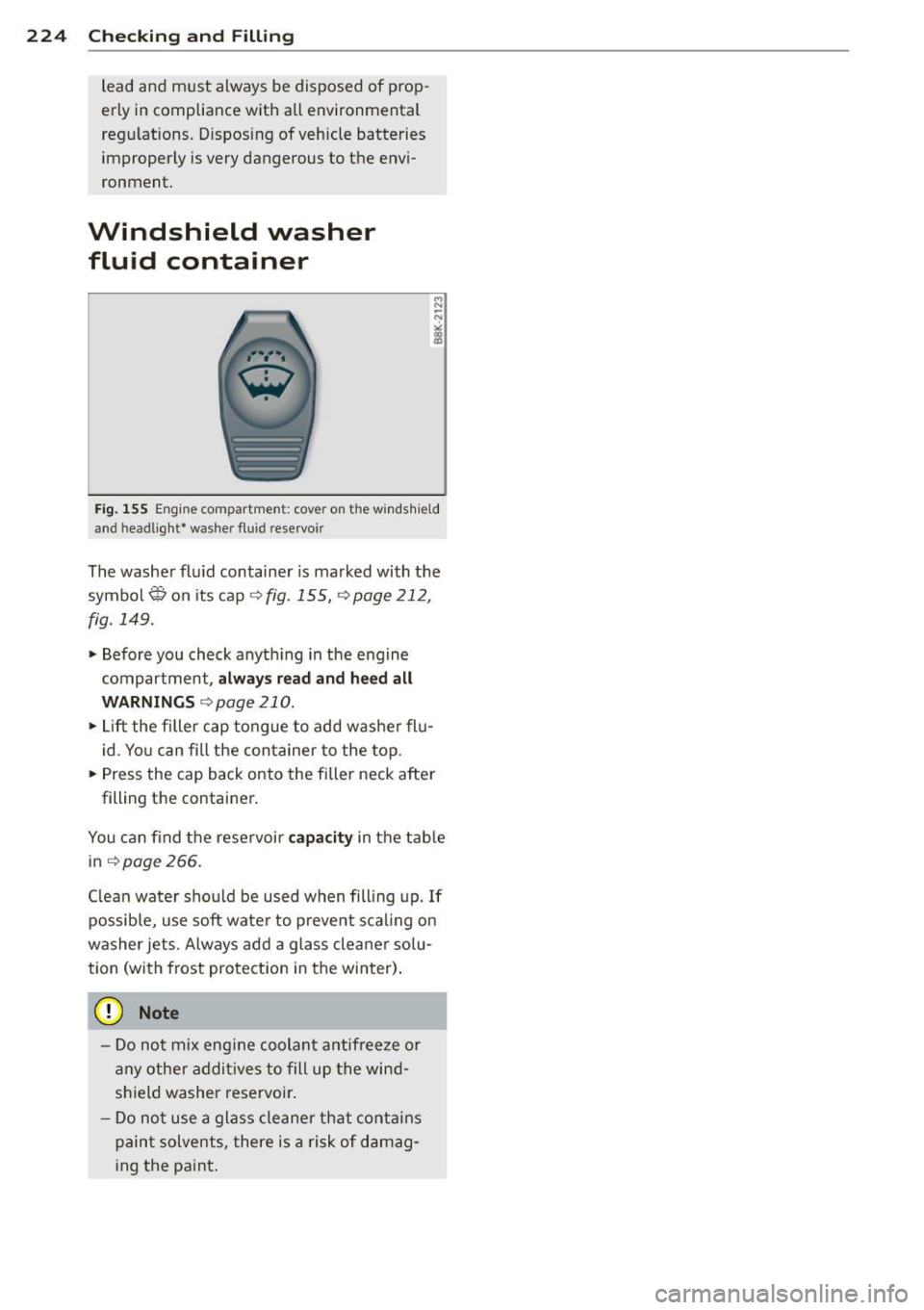
224 Checking and Filling
lead and must always be disposed of prop
erly in compliance with a ll environmental
regulations. D isposing of vehicle batteries
improperly is very dangerous to the envi
ronment.
Windshield washer
fluid container
Fig. 155 Engine co mp artmen t: cove r on the wind shield
an d h ead ligh t* washer fluid rese rvo ir
The washer flu id container is marked with the
symbol Won its cap
~fig. 155, ~page 212 ,
fig. 149 .
.. Before you check anyth ing in the engine
compartment,
always read and heed all
WARNINGS ~page 210 .
.. Lift the filler cap tongue to add washer flu
id. You can fill the container to the top .
.. Press the cap back onto the f iller neck after
filling the container.
You can find the reservoir
ca pa city in the table
in ~
page 266 .
C lean water should be used when filling up.
If
possible, use soft water to prevent scaling on
washer jets. A lways add a glass cleaner solu
tion (with frost protection in the winter) .
@ Note
- Do not mix engine coolant antifreeze or
any other additives to fill up the wind
shield washer reservoir.
- Do not use a glass cleaner that contains
paint solvents, there is a risk of damag
ing the paint.
Page 228 of 288
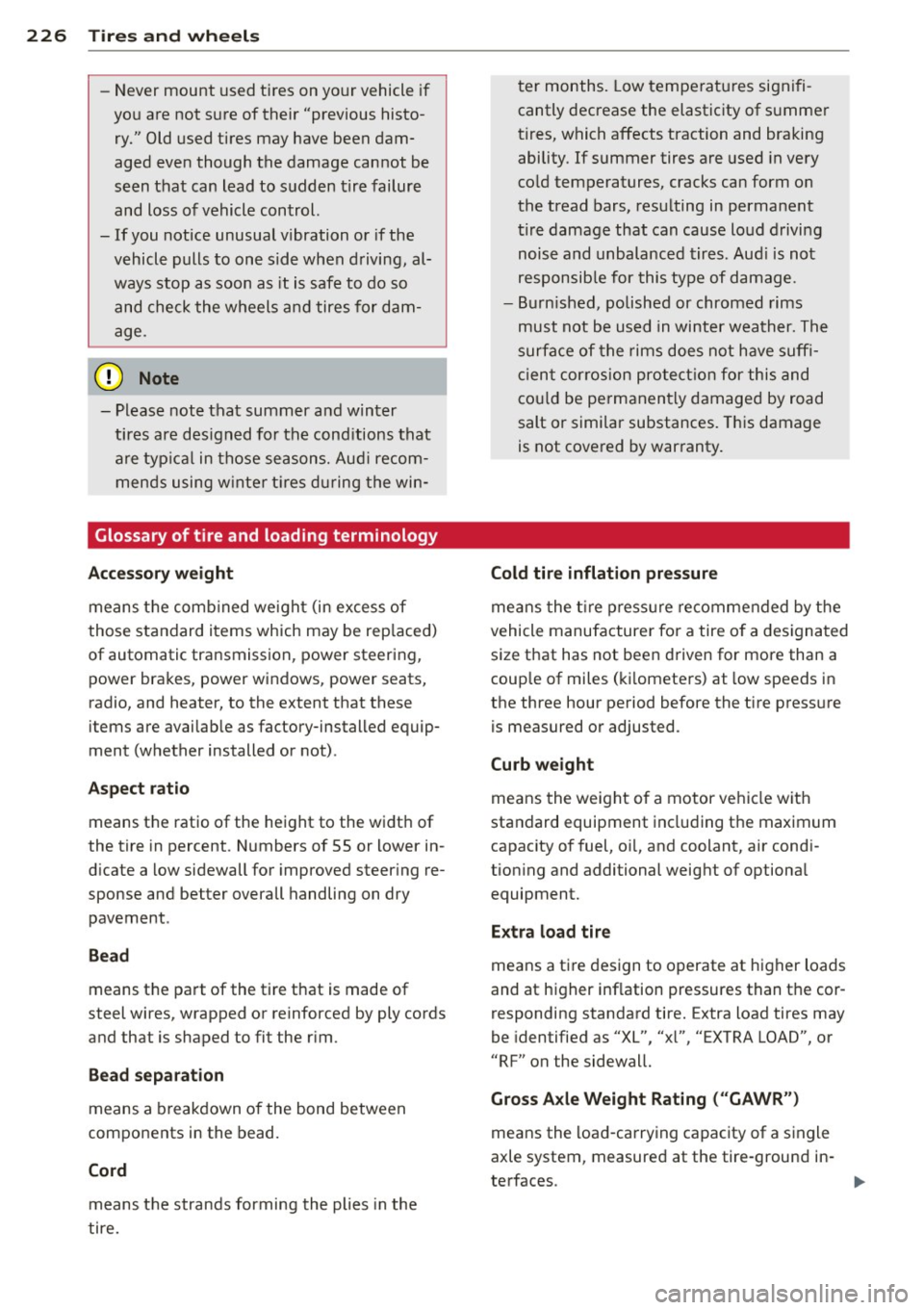
226 Tire s and wheel s
-Never mount used tires on yo ur vehicle if
you are not sure of their "previous histo
ry." Old used tires may have been dam
aged even though the damage cannot be
seen that can lead to sudden t ire failure
and loss of vehicle control.
- If you notice unusual vibration or if the
vehicle pulls to one side when driving, al
ways stop as soon as it is safe to do so
and check the wheels and tires for dam
age.
(D Note
- Please note that summer and winter
tires are designed for the cond itions that
a re typ ica l in those seasons. Aud i recom
mends using w inter t ires d uring the win-
Glossary of tire and loading terminology
Accessory weight
means t he comb ined we ight (in excess of
those standard items which may be rep laced)
of automatic transmission, power steering,
power brakes, power windows, power seats,
radio, and heater, to the extent that these
items are availab le as factory-installed equip
ment (whether installed or not).
A spect ratio
means th e ratio of the height to the width of
the tire in percent. Numbers of 55 or lower in
d icate a low sidewall for improved steer ing re
sponse and better overall handling on dry
pavement .
Bead
means the part of the tire th at is made of
steel wires, wrapped or reinforced by ply cords
and that is shaped to fit the rim.
Bead s eparation
means a breakdown of the bond between
components in the bead.
Cord
means t he strands forming the plies in the
tire. ter months.
Low tempe ratu res signifi
cantly decrease the elasticity of summer
tires, which affects traction and braking ability. If summer tires are used in very
co ld temperatures, cracks can form on
the tread bars, resu lting in permanent
tire damage that can cause loud driving
noise and unbalanced tires. Aud i is not
responsib le for this type of damage.
- Burn ished, polished or chromed rims
must not be used in winter weather. The
surfa ce of the rims does not have suff i
c ien t cor rosion prote ct io n for this and
co uld be pe rmanen tly damaged by road
salt or simi lar substances. This damage
is not cove red by war ranty.
Cold tire inflat ion pre ssure
mea ns the t ire press ure recommended by the
vehicle manufacturer for a tire o f a des ignated
size that has not bee n driven for more than a
coup le of miles (ki lometers) at low speeds in
the three hour period before the tire press ure
is measured or adjusted.
Curb weight
means the weight of a motor vehicle w ith
standard equipment including the maximum
capacity of fuel, o il, and coolant, air condi
tion ing and additional weight of optional
equipment.
E x tra load tire
means a tire design to operate at higher loads
and at higher inflation pressures than the cor
responding standard tire. Extra load tires may
be identified as "XL", "xl", "EXTRA LOAD", or
"RF" on the sidewall.
Gross A xle Weight Rating ("GAWR")
means the load-carrying capacity of a single
axle system, measured at the tire-ground in-
terfaces.
IJ>,
Page 267 of 288
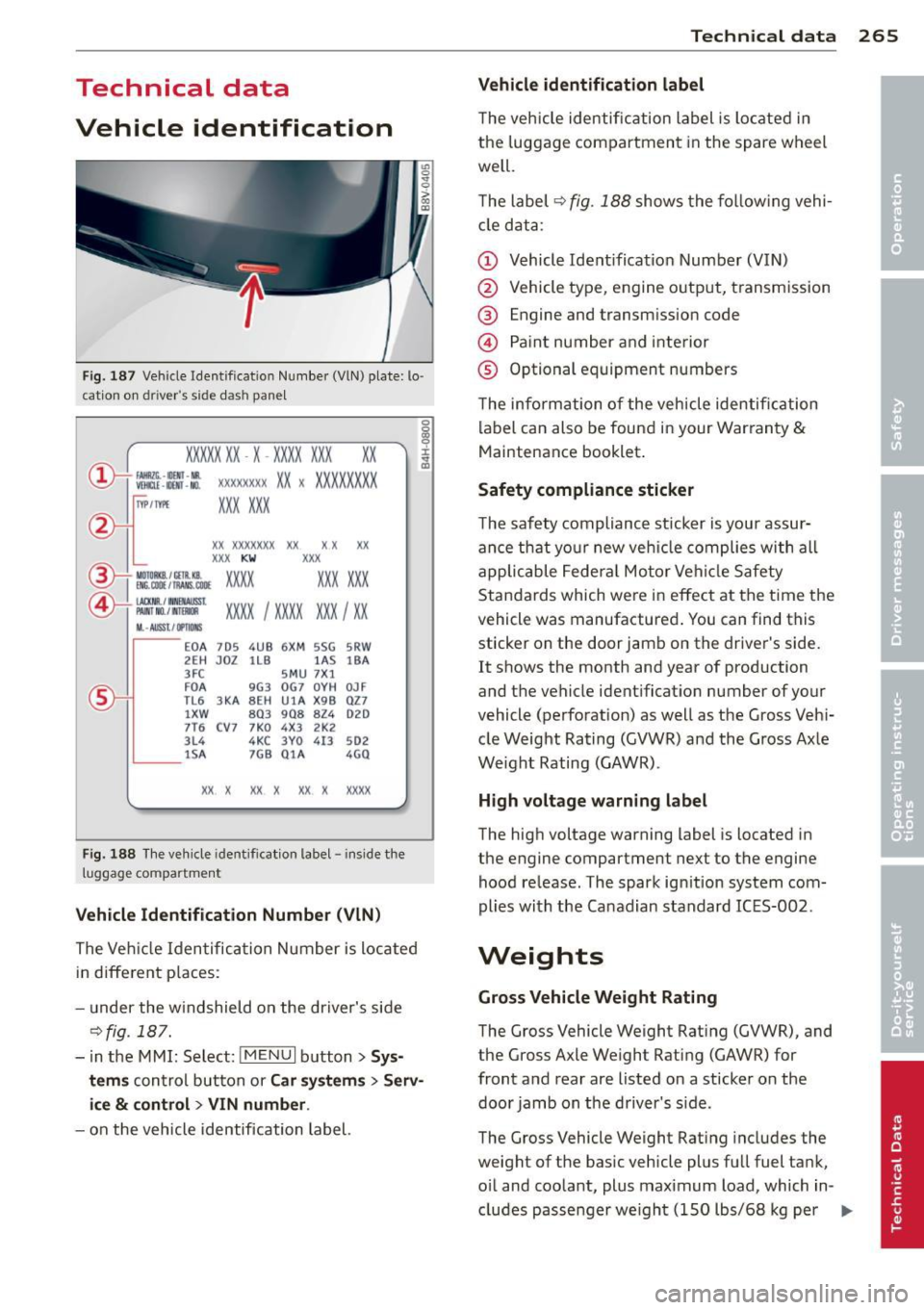
Technical data
Vehicle identification
F ig. 187 Veh icle Identificat ion Number (VlN) plate: lo·
cat ion on driver's side dash pane l
XXXXX XX · X -XXXX XXX
~ fAllftlli. -llllll · NR. ~ W!ru -llllll -NO.
xx
XXXX XXXX XX X XXXXXXXX
XXX XXX
IYP /TYPE
XX XXXX XXX XX X X XX
XXX
KW XXX
®i ~W.::·f :l~~ XXXX XXX XXX
©+ ::rw= xxxx I xxxx XXX I xx
M. · AUSSt I IJ'IIDIIS
EOA 7D5 4UB 6XM SSG SR W
2EH JOZ 1LB lAS
18A
3FC SMU 7Xl
FDA 9G3 OG7 OYH
OJF
TL6 3KA 8EH
UlA X98 027
l XW 803 908 824 D2D
7T6 CV7 7KO 4X3 2K2
3L4 4KC 3YO 413 502
1SA 7GB 01A 4GO
XX . X XX X XX X XXXX
Fig. 188 The vehicle identification label- in side the
l uggag e compartme nt
Vehicle Identification Number (VlN)
The Veh icle Identifica tion Number is located
in different p laces :
- under the w indshield on the driver's side
¢fig. 187.
- in the MMI: Select: !MENUI button> Sys
tems
control button or Car systems > Serv
i ce
& co ntrol > VIN number .
-on the vehicle identification label.
Technical data 265
Vehicle identification label
The vehicle identification label is located in
the luggage compartment in the spare wheel
well.
T he label¢
fig. 188 shows the following vehi
cle data:
(D Vehicle Identification Number (VIN)
@ Vehicle type, engine output, transmission
® Engine and transmission code
© Paint number and interior
® Optional equipment numbers
The information of the veh icle identification
label can also be found in your Warranty
&
Maintenance booklet .
Safety compliance sticker
The safety compliance sticker is your assur
ance that your new vehicle complies with all
applicable Federal Motor Vehicle Safety
Standards which were in effect at the time the
vehicle was manufactured . You can find this
sticker on the door jamb on the driver's side.
It shows the month and year of production
and the vehicle ident ification number of your
vehicle (perforation) as well as the Gross Vehi
cle Weight Rating (GVWR) and the Gross Axle
Weight Rating (GAWR) .
High voltage warning label
The high voltage warning label is located in
the engine compartment next to the engine
hood release. The spark ignition system com
plies with the Canadian standard ICES-002 .
Weights
Gross Vehicle Weight Rating
The Gross Vehicle Weight Rating (GVWR), and
the Gross Axle Weight Rating (GAWR) for
front and rear are listed on a sticker on the
door jamb on the driver's side.
The Gross Vehicle Weight Rating includes the
weight of the basic vehicle plus full fuel tank,
o il and coolant, plus maximum load, which in
cludes passenger we ight (150 lbs/68 kg per
II>--
Page 272 of 288
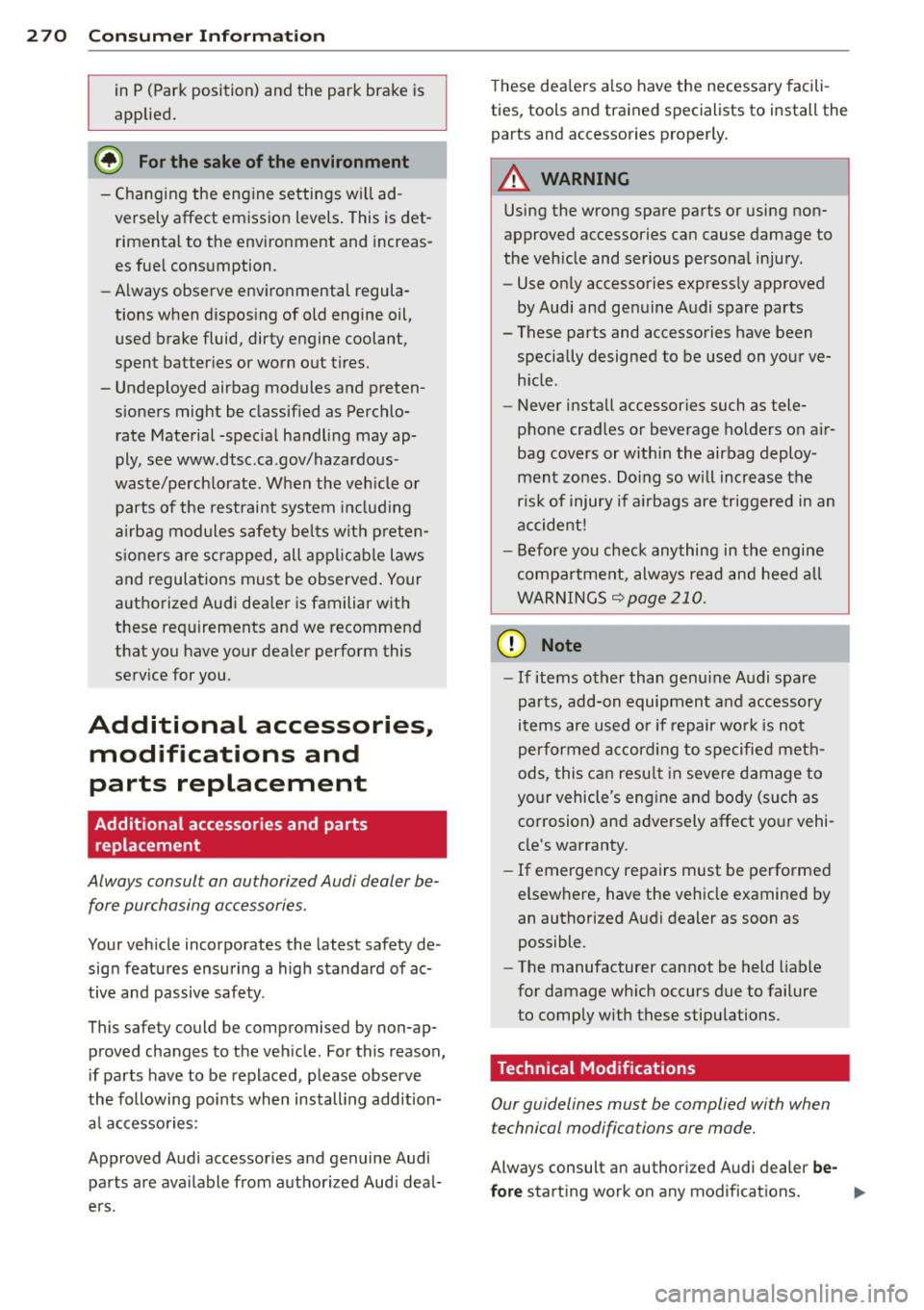
2 70 Con sum er Inf ormation
in P (Park position) and the park brake is
applied.
@) For the sake of the environment
- Changing the engine settings wi ll ad
versely affect emission levels . This is det
rimental to the environment and increas
es fue l consumption .
- Always observe env ironmental regula
tions when disposing of old engine oil,
used brake fluid, dirty engine coolant,
spent batteries or worn out tires.
- Undeployed airbag modules and preten
sioners might be classif ied as Perchlo
rate Material -spec ial handling may ap
ply, see www .dtsc .ca .gov/hazardous
waste/perch lorate . When the veh icle o r
parts of the restraint system including
airbag modules safety belts wit h preten
s ioners are scrapped, all appl icable laws
and regulations must be observed. Your
a utho rized Audi dea ler is familiar with
these requirements and we recommend
that you have your dealer perform this
serv ice for you .
Additional accessories,
modifications and
parts replacement
Additional accessories and parts
replacement
Always consult an authorized Audi dealer be
fore purchasing accessories .
Your vehicle incorporates the latest safety de
sig n features ensuring a high standard of ac
tive and passive safety .
This safety could be compromised by non-ap proved changes to the veh icle. For this reason ,
if parts have to be replaced, p lease observe
the following points when installing addition
a l accessories:
Approved Audi accessor ies and genuine Audi
parts a re ava ilable from authorized Aud i deal
e rs. These dea
lers a lso have the necessary facili
ties, tools and trained specialists to install the
parts and accessories proper ly .
A WARNING
=
Using the wrong spare parts or using non-
approved accessories can cause damage to
the veh icle and ser ious perso na l injury .
- Use on ly accessories express ly approved
by Audi and genuine Audi spare parts
- These parts and accessories have been
specia lly designed to be used on your ve
h icle.
- Never install accessor ies such as tele
phone crad les or beverage ho lders on a ir
bag covers or within the airbag deploy
ment zones . Do ing so wi ll increase the
ris k of injury if a irbags are triggered in an
accident!
- Before you check anything in the engine
compa rtment, always read and heed a ll
WARNINGS
c:::> page 210 .
(D Note
-If items other than genu ine Audi spare
parts, add-on equipment and accessory
items are used o r if repair wo rk is not
performed ac cord ing to spe cified meth
ods, this c an resu lt in seve re damage to
yo ur vehicle's eng ine and body (such as
co rrosion) and adversely affect yo ur vehi
cle's warranty.
- If emergency repairs must be performe d
elsewhere , have the vehicle examined by
an authorized Audi dealer as soon as
possible.
- The manufacturer cannot be held liable
for damage wh ich occ urs due to failure
to comply with these stipu lations.
Technical Modifications
Our guidelines must be complied with when
t echnical modifica tions are made.
Always consult an authorized Audi dealer be-
fore start ing work on any modifications. ll>-
Page 274 of 288
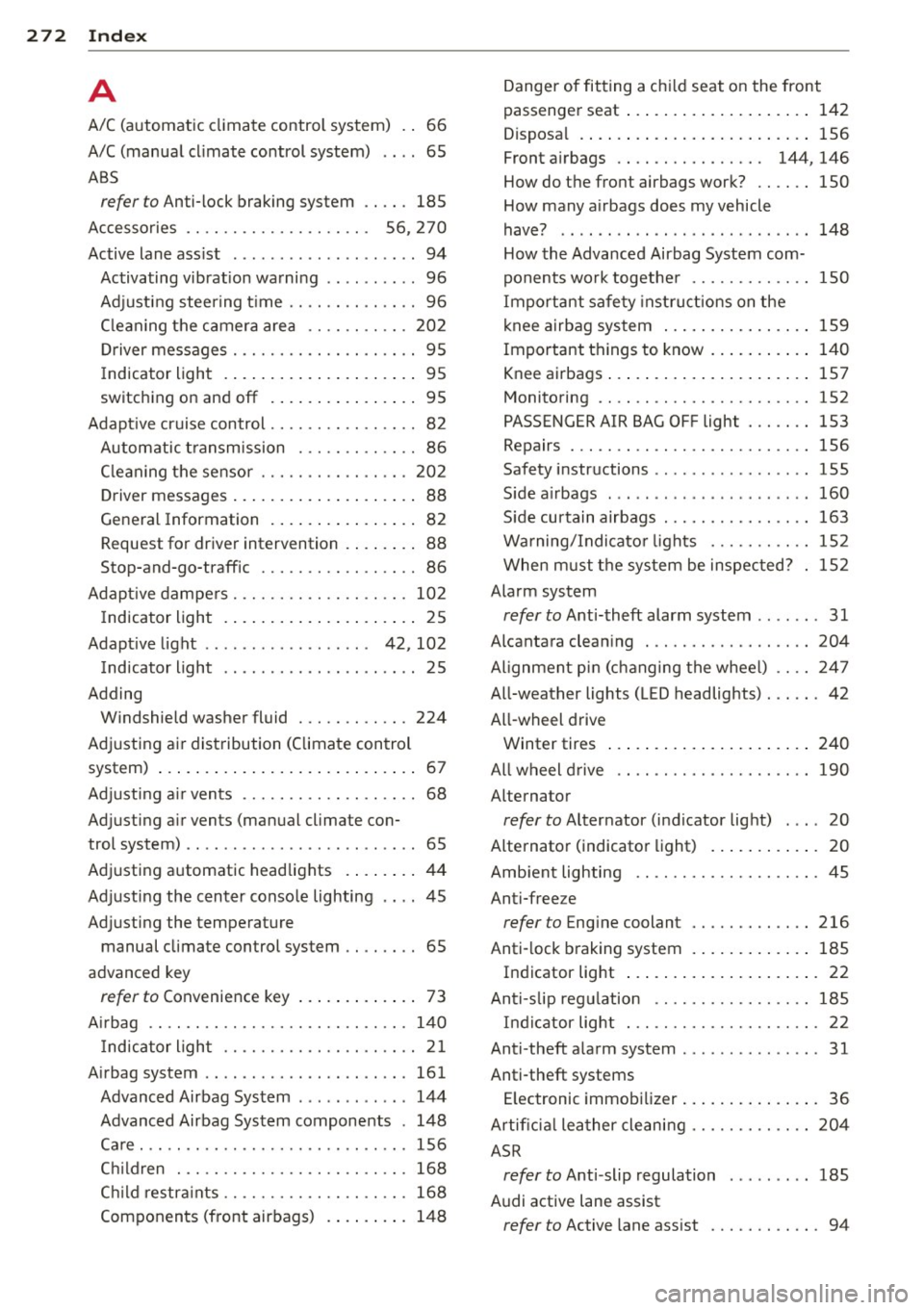
272 Index
A
A/C (a utomatic cl imate control system)
A/C (manual cl imate control system)
ABS 66
65
refer to An
ti-lock braking system . . . . . 185
Accessories . . . . . . . . . . . . . . . . . . . . S6, 270
Active lane ass ist . . . . . . . . . . . . . . . . . . . . 94
Activating vibration wa rning .. .. .. .. .. 96
Adj ust ing steering t ime .... .. .. .... .. 96
C lean ing the camera area .. .. .. .. .. . 20 2
Dr iver messages . . . . . . . . . . . . . . . . . . . . 95
I ndicator light . . . . . . . . . . . . . . . . . . . . . 95
switch ing on and off . ... .. .. .. .... .. 95
Adapt ive cruise control . . . . . . . . . . . . . . . . 82
Automatic t ra nsm ission ... .. .. .... .. 86
C lean ing the senso r ..... .. .. .. .. .. . 202
D river messages . . . . . . . . . . . . . . . . . . . . 88
General Information . . . . . . . . . . . . . . . . 82
Request for driver intervention . . . . . . . . 88
Stop-and-go-traffic . . . . . . . . . . . . . . . . . 86
Adapt ive dampers .......... .. .. .... . 102
I ndicator light . .. ..... ... .. .. .... .. 25
Adapt ive light . . . . . . . . . . . . . . . . . . 42, 102
I ndicator light . . . . . . . . . . . . . . . . . . . . . 25
Adding W indshield washer fluid ..... .. .... . 224
Ad justing ai r dist ribution (Climate con trol
system) ..... ... .. ..... ... .. .. .... .. 67
Ad justing a ir vents ......... .. .. .... .. 68
Ad justing a ir vents (manual climate co n-
trol system) . . . . . . . . . . . . . . . . . . . . . . . . . 65
Ad justing automatic headlights . .. ... ..
44
Ad justing the center conso le lighting .... 45
Ad justing the temperat ure
manual climate control system . . . . . . . . 65
advanced key
refer to Convenience key . . . . . . . . . . . . . 73
A irbag .. .. .. ... .......... .. .. .. .. . 14 0
I nd icator ligh t . . . . . . . . . . . . . . . . . . . . . 2 1
A irbag system ... ....... ... .. .. .. .. . 161
Advanced Airbag System ....... .. .. . 144
Advanced Airbag System components . 148
Ca re . .. .. .. ............. .. .. .. .. . 156
C hi ldren . .... ........... .... .... . 168
C hil d restra ints ........... .. .. .... . 168
Components (front airbags) . ... .. .. . 1 48 Danger of fitting a ch
ild seat on the front
passenger seat ... .. ... ..... ... .. .. 142
Disposa l .. .. .. .. ... .. ..... ... .. .. 156
Front a irbags . . . . . . . . . . . . . . . . 144, 146
How do the front airbags work? .. .... 150
How many a irbags does my vehicle
have? ...... .. .. .. ... ... ... .. .. .. 148
How the Advanced Airbag System com-
ponen ts wo rk togethe r ......... .. .. 150
Im port ant sa fe ty inst ru cti ons on the
k nee airbag system .. .. ..... ... .. .. 159
Impo rtant things to know .. ... ... . .. 140
Knee airbags ..... .. ... ..... ... .. .. 157
Monitoring .... .. ............. .... 152
PASSENGER AIR BAG OFF light ... .... 153
Repairs ... .... .. ............. .... 156
Safety instructions ................. 155
S ide a irbags ... .. ... .. .. ... ..... .. 160
S ide curtain airbags ... ...... ... .. .. 163
Warning/Indicato r lights ..... .. .. .. 152
When must the system be inspec ted? . 152
Alarm system
refer to Anti-theft alarm system . . . . . . . 31
Alcantara clean ing .............. .... 204
Al ignment pi n (changing the whee l) .. .. 24 7
All-weather lights (LED headlights) . .. .. . 42
All-wheel drive Winter tires ..... .. ... ..... ... .. .. 240
All wheel d rive . . . . . . . . . . . . . . . . . . . . . 190
Alternator
refer to A lternator (indicator light) . .. . 20
Alternato r (indicato r light) .. ... .. .. .. . 20
Amb ient lighting .. ............. .... . 45
Anti-free ze
refer to Eng ine coolant
216
Anti -lock b raking system . ..... ... .. .. 185
Indicator light ... ... .. ..... .... . .. . 22
An ti-s lip reg ulatio n ............. .. .. 185
Indi cator ligh t ... ............. .. ... 22
Anti -theft a la rm system . . . . . . . . . . . . . . . 31
Anti-theft systems Electronic immob ilizer .. ..... ... .. .. . 36
Artific ia l lea ther cleani ng ........... .. 20 4
ASR
refer to Anti -slip regulation
A udi active lane assist 185
refer to Active
lane ass ist ....... .... . 94
Page 277 of 288
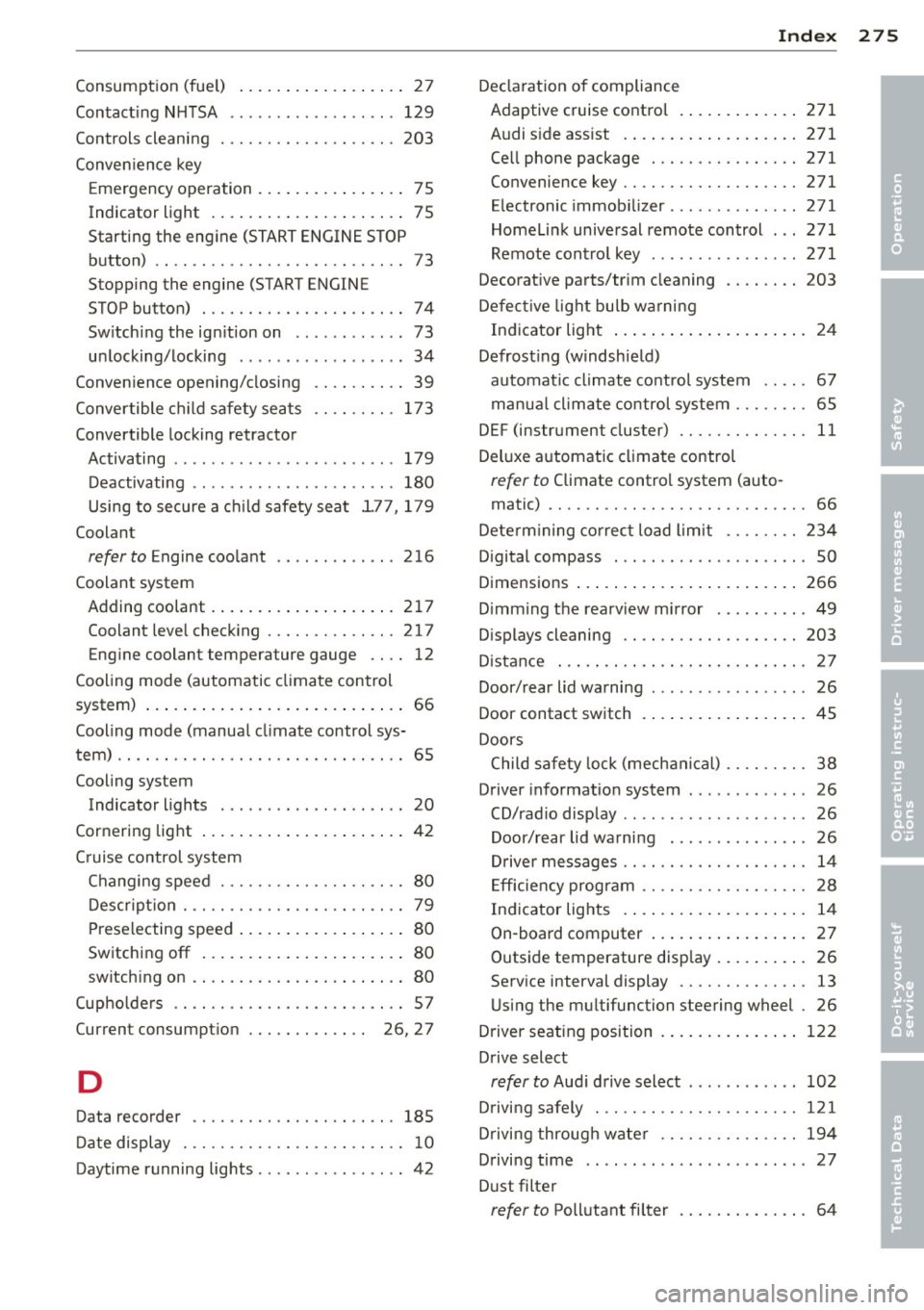
Consumption (fuel) ... ..... .. .. .. .. .. 2 7
Contact ing N HTSA .............. .... 129
Controls cleaning .......... .... .. .. . 203
Conven ience key
E mergency operation ... ... .. .. .. .. .. 75
I ndicator light . . . . . . . . . . . . . . . . . . . . . 7 5
Starting the engine (START ENGINE STOP button) .. .. ................. .. .... 73
Stopping the engine (START ENGINE
STOP bu tton) ............ .... .. .. .. 74
Sw itch ing the ign ition on ......... ... 73
un locking/locking ........... .... ... 34
Conven ience opening/closing .. .. .. .. .. 39
Conver tible c hild safety sea ts .. .. .. .. . 173
Convertible locking retractor
Activating . . . . . . . . . . . . . . . . . . . . . . . .
179
D eactivating ................ .. .... 180
Using to secure a c hild safety sea t
1.7 7, 179
Coolant
refer to Engine coo lant ..... ... ... .. 216
Coolant system
Adding coolant . ... .... ... .. .. .. .. .
2 17
Coolant leve l check ing ..... .. .. .. .. . 217
Eng ine coolant temperature gauge .. .. 12
Cooling mode (automatic clima te con trol
system) ..... .. ... .. ..... ... .. .. .... 66
Cooling mode (manua l cl imate control sys-
tem) ...... .. ................. .. .... 65
Cooling system Indicator lights . . . . . . . . . . . . . . . . . . . . 20
Cornering light .... ..... ... .. .. .. .. .. 42
C ruise control system
C hanging speed . . . . . . . . . . . . . . . . . . . . 80
D escr ipt ion . ............. .. .. .. .. ..
79
P rese lecting speed . . . . . . . . . . . . . . . . . . 80
Sw itching off .. .. ..... ... .. .. .. .. .. 80
switch ing on . ... .. .... ... .. .. .... .. 80
(upho lde rs . . . . . . . . . . . . . . . . . . . . . . . . . 5 7
Current consumpt io n . . . . . . . . . . . . .
26, 27
D
Data recorder . . . . . . . . . . . . . . . . . . . . . . 185
D ate display . ............. .... .. .... 10
Daytime running lights .......... ... ... 42
Inde x 275
Declarat ion of compliance
Adaptive cruise contro l .. .... ... .. ..
2 71
A udi s ide ass ist . ... . .. ... .... ... .. 2 7 1
Ce ll phone package ................ 271
Convenience key .. .... ............. 271
Electronic immob ilizer ............. . 271
Homelink universal remote con trol ... 271
Remote cont ro l key ............... . 271
Decorative parts/tr im cleaning .... .. .. 203
De fec tive light bu lb w arning
Ind icator light ..... . .. .. ..... ... .. . 2 4
Defrost ing (w indsh ie ld)
automat ic cl imate control system .. .. .
6 7
man ua l cl imate co ntrol system ... .. .. . 65
DEF (instrument clus ter) ......... .. .. .
11
Del uxe a utomatic climate control
refer to Climate contro l system (auto -
matic) .... .. .. .. ................. .
66
Determining co rrec t load l imit .... .. .. 234
D igital compass . . . . . . . . . . . . . . . . . . . . . 50
Dimensions ....... .. . .. .. ..... ... ..
266
D imming the rearv iew mi rror ..... .. .. . 49
D isplays cleaning .. ................. 203
D istance ... .. .. .. .. . .. ... .... ... .. .
27
Door/ rear lid warning . .. .. ...... .... .. 26
Door contact switch . . . . . . . . . . . . . . . . . . 45
Doors Child sa fety lo ck (mech ani cal) .... .. .. . 38
Driver informat io n system ........... ..
26
CD/rad io disp lay .. .. . .. .... .... .. .. . 26
Door/rear lid wa rni ng . ...... ... .... . 26
Drive r messages . . . . . . . . . . . . . . . . . . . . 14
E ff iciency program . . . . . . . . . . . . . . . . . . 28
Ind icator lights .... . .. .. ..... ... .. . 14
On-board computer .. .. ..... ... .. .. .
27
Outside temperature disp lay .. ... .. .. . 26
Serv ice interval display . . . . . . . . . . . . . . 13
U sing the mu ltifunction steering wheel .
26
Driver seating position ... ..... ... .. .. 122
D rive select
refer to Aud i d riv e select ........... . 102
D riving safely . . . . . . . . . . . . . . . . . . . . . .
121
Drivi ng throug h wate r ........... .. .. 194
Driving time . . . . . . . . . . . . . . . . . . . . . . . .
27
D ust filter
refer to Poll utant fi lter ......... .... . 64
•
•
•